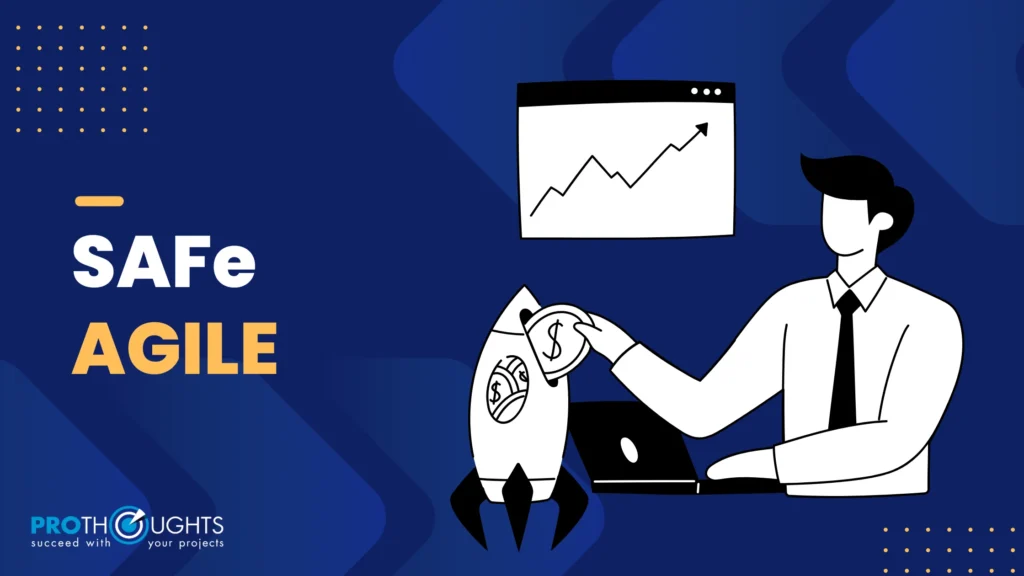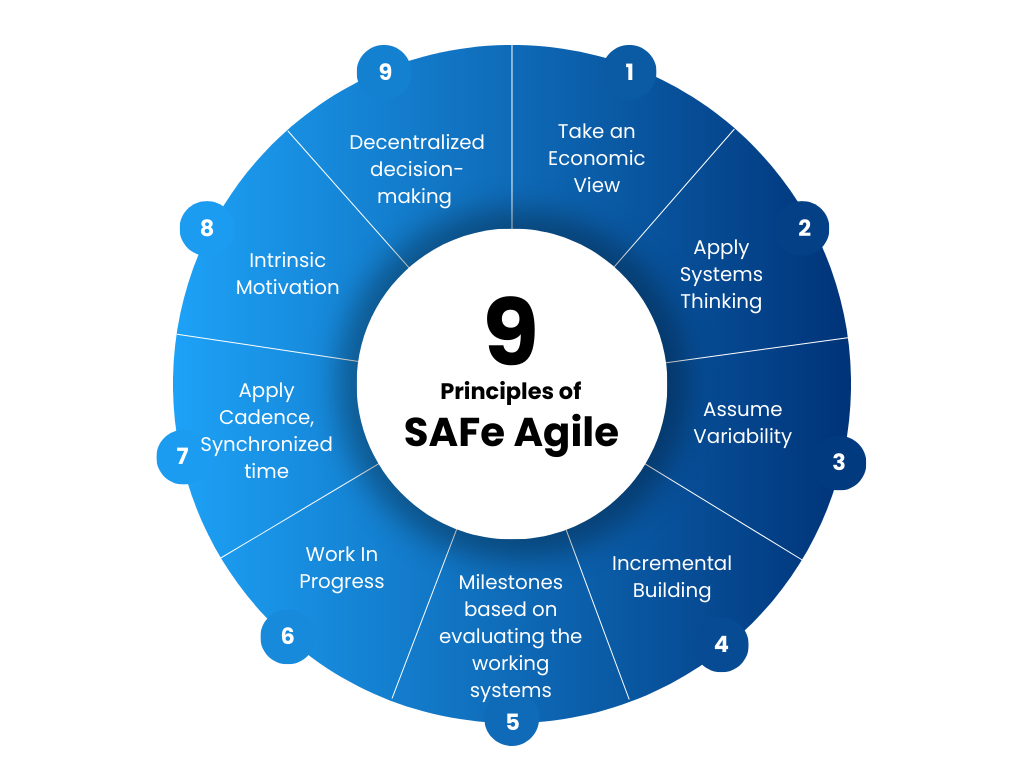
Imagine your organization is completely disorganized, with no coordination, and each team member performs their duty without consulting or asking the leader. Now if all of these tasks were completed in perfect synchrony, yielding the intended results and a sense of success, how would you like it? That is what SAFe Agile or Scaled Agile Framework does!
SAFe Agile is a set of principles, rules, guidelines, and practices that guide the organization to achieve the agile methodology through large, complex projects and teams. It is a valuable strategy that allows the organization to operate together effortlessly, ensuring that everyone is working and coordinating together, that projects go well, and that consumers’ demands are met more quickly.
What is SAFe Agile?
The SAFe Agile is an agile framework designed for development teams. It assists in scaling Agile and expanding along with software development organizations as they grow. Furthermore, it serves as a guide for team members to move faster and produce better value delivery for their consumers. It offers them flexibility along with ensuring successful product delivery.
SAFe Agile comprises three pillars i.e. Team, Program, and Portfolio. Thus, it promotes delivery, teamwork, and task alignment across several interconnected Agile teams. SAFe is possibly the best-known of the various scaled Agile frameworks available to enterprises today.
What is the History of SAFe Agile?
Dean Leffingwell founded the SAFe Agile framework in the 2000s to make it easier for organizations to apply Agile concepts and practices on a large scale. Before the launch, big teams and companies needed help to successfully manage and deploy agile principles.
Leffingwell addressed these problems by developing a framework that assists organizations in implementing agile principles in a flexible and coordinated manner aligned with their needs and size. In today’s time, is one of the most famous agile frameworks and its complete catalog of knowledge and success pointers are available free of cost.
What are the Principles of SAFe Agile?
Here are the nine SAFe Agile principles that impact and implement higher authority’s choices and teams within the organization. It also sets everyone’s perspective for adopting and implementing the lean-agile technique in their process. These principles derive from the traditional agile and lean principles, built on nine key concepts.

1. Take an Economic View
For any business owner, it is important to understand the economics of building the best quality products for their consumers. Here, the emphasis is on delivering value in smaller, manageable pieces and considering the overall economic impact on each value stream. An accurate understanding of economics makes it easier to make better decisions.
SAFe requires that everyone, from the leader to the team members, understand the implications of their decisions in order to avoid the causes of unsuccessful products or solutions. This is why economics is one of the most critical SAFe Agile concepts for minimizing future troubles in any firm.
2. Apply Systems Thinking
Edwards Deming found that to easily recognize the obstacles in the workplace and the marketplace, it is crucial to understand the systems in which employees and users function. SAFe Agile system thinking applies to three areas, solutions, enterprise system building, and value streams. Knowing and understanding these three areas enables the leader and team to determine the complexity of generating solutions, organizing everything appropriately, and the time required for a product to be launched or released in the market.
3. Assume Variability
Rather than striving to eliminate variability and the inevitable need for adjustments in projects and products, SAFe encourages development teams to use proactive set-based designs and be open to possibilities that can be adjusted as teams move toward project or product completion.
4. Incremental Building
SAFe recommends building project solutions progressively with quick, integrated learning cycles whereby each one builds on the last. It focuses on breaking down projects into smaller components, learning from each one, and applying that information to better the next. This allows teams to steadily improve their work and produce good results over time.
5. Milestones based on evaluating the working systems
Throughout the development process, SAFe promotes the use of functional systems as models to measure progress and collect feedback from stakeholders. This allows for more informed decision-making and the planning of realistic milestones. As a result, teams can successfully plan for and adapt to changing needs and stakeholder expectations.
6. Work In Progress
SAFe makes it easy to picture out and limit the work in progress. It insists on reducing the number of jobs to smaller chunks and managing the activities that need to be completed and are in a long queue. This makes it easier to complete and control the flow of work until a project or product is complete.
7. Apply Cadence, Synchronized time
This SAFe Agile principle states how one should coordinate with the timings and how to plan across different areas of the project. The usage of cadence is a technique to reduce the complexity while creating a rhythm, sequence, or flow for the development. It creates a routine or flow that allows the developers to focus on dynamic parts of the development. Synchronizing the cadence offers multiple viewpoints that are to be considered and implemented at the same time. In simpler terms, This principle focuses on keeping everyone and everything in sync and on track to achieve goals successfully.
8. Intrinsic motivation
This principle looks towards unleashing the best out of the team members through motivating them. There are many ways in which this can be achieved by providing workers with a good working environment, minimizing constraints, supporting by providing fair pay, encouraging feedback, and flexibility within project or product delivery constraints. If the workers or teams are motivated well, they tend to produce better results for the organization and themselves.
9. Decentralized decision-making
SAFe Agile allows team members to self-organize and make timely decisions that advance the project, while also encouraging leaders to concentrate more on strategic decision-making. For this decentralized decision-making is necessary to produce such results. When a team member or worker needs to reach out to their leaders to make a decision, it always results in a delay. So, in this case, this principle permits workers to make decisions for themselves, with the exception of important strategic importance, which is chosen by the leaders themselves.
What are the 4 Levels of SAFe Agile?
SAFe Agile has four levels in it. Every level works in a different pattern and style. The team members work at different levels to fulfill the customer’s needs by delivering value and achieving the organizational goals effectively. Here are the four levels:
1. Team Level
At this level, the Agile team members practice Scrum or Kanban to plan, execute, and review the work done by them. This is where the team works to deliver small pieces of value.
2. Program Level
At this level, multiple agile teams work together to deliver value to the organizations of a software product or system. At this level, not just one team but multiple teams come together and work collaboratively. They focus more on planning sessions and regular meetings to work together effortlessly and in sync, making sure all are moving forward towards the same goals.
3. Large Solution Level
Large Solution SAFe is appropriate for groups working on large-scale, complex projects that call for cooperation across several teams and stakeholders. Architectural runways, value streams, and solution backlogs are some of the extra components that are included in this level. Particularly, organizations with up to ten Agile teams find that Large Solution SAFe works best for them.
4. Portfolio Level
At this level, the major preference is given to managing big-picture strategies and investments across the entire organization. It makes sure that all the significant projects and initiatives synchronize with the organization’s total business goals. It ensures that resources like time, funds, and workforce are used efficiently to deliver the most value. Through proper coordination and prioritizing these efforts, it becomes easy for the organization to achieve its desired goals.
What are the Benefits of SAFe Agile?
SAFe Agile has a lot of advantages. Here are a few of these:
1. Improves collaboration and teamwork
SAFe Agile focuses on promoting cross-functional teamwork and collaboration between the team members and stakeholders that lead to efficient communication, employee involvement in the task, and achieving desired results.
2. Faster time to market
SAFe Agile guides the product team to immediately respond to customers’ needs and market situations. This enables them to pull into new features and techniques in the market faster than the competitors.
3. Innovation and Competition
SAFe Agile helps the organization improve, experiment, and innovate to stay ahead of the curve and stay competitive in their field.
4. Aligning with goals and objectives
SAFe Agile helps in aligning with the business goals and objectives. It focuses on aligning the activities of development teams with a wider scope of goals and objectives. By doing this it ensures that the resources and funds are used and invested in the right programs and deliver value to stakeholders.
Overall, SAFe aims to maintain harmony between flexibility and structure, making it a most favored choice for organizations looking to achieve agility at scale along with maintaining organizational alignment and efficiency.
SAFe Agile Certification & Training
Training modules for SAFe Agile usually last two to four days, depending on the topic. Following the course, future practitioners can prepare for a multiple-choice certification exam in their chosen discipline with a little further reading and study.
SAFe offers a host of certifications available to almost anyone working with the framework. Becoming a Certified SAFe in:
- Lean Portfolio Manager, Certified SAFe Agilist,
- Practitioner, or
- Program Consultant prepares people to practice, implement, and introduce SAFe in organizations at a more holistic level.
SAFe Agile Certification & Training emphasizes learning the best practices and techniques for managing products in a SAFe Agile environment.
Conclusion
In simple terms, SAFe Agile is helpful for large organizations to adopt agile practices, enhancing the synchronization, transparency, and value delivery speed. It ensures the team responds to market and customer needs and fosters continuous improvement and quality. Therefore, to become a SAFe Agilist one needs to undergo training and obtain certification. It empowers professionals to lead agile transformations effectively.
FAQs
Q1. What is Agile vs SAFe Agile?
A. Agile is a flexible method for individual teams to deliver projects in smaller chunks known as “sprints”. It provides faster feedback and improvement. Whereas, SAFe Agile expands on these ideas to coordinate with many teams within a large enterprise, which aids in controlling complexity and synchronizing across the entire project.
Q2. What is SAFe Agile in simple terms?
A. SAFe Agile is a framework for large organizations to work together efficiently, ensuring teams communicate well, stay focused on common goals, and deliver high-quality results consistently. It’s like a structured approach that helps everyone in a big organization collaborate smoothly to achieve their objectives faster and more effectively.
Q3. What are the 4 levels of SAFe Agile?
A. SAFe Agile has four tiers. Each level follows a particular pattern and style. It enables organizations to effectively implement Agile techniques. Furthermore, it has a clear structure for delivering high-quality software and systems quickly. The four levels are Team, Portfolio, Program, and Large Solutions.
Q4. What is the concept of SAFe Agile?
A. The concept behind SAFe Agile is simple and straight. It helps large organizations function more efficiently by managing teams, staying on track with defined goals, and consistently providing high-quality work.
Q5. What is SAFe Agile vs Scrum?
A. SAFe Agile is built for larger organizations with several teams, whereas Scrum is designed for smaller, individual teams of 5-9 members. Second, it provides a framework with four levels, whereas scrum focuses on short cycles known as “sprints”.
Q6. Is SAFe Agile any good?
A. Yes, SAFe Agile is very successful for corporations since it helps them handle difficult projects by implementing agile methods across many teams. It focuses on improved coordination, faster delivery of high-quality goods, and alignment with shared corporate objectives. Acquiring expertise in agile processes, on the other hand, necessitates considerable work and training.
Q7. Is SAFe agile free?
A. It isn’t free. Though there are free fundamental information and materials available on the internet that may be referred to for extensive guidelines, training, and resources.
Q8. Is SAFe agile certification easy?
A. SAFe Agile is a tough certificate because it necessitates a thorough understanding of the concept and methods. However, with sufficient study, training, and preparation, it becomes possible to pass the exam efficiently.
Q9. How long is SAFe agile?
A. SAFe Agile training varies in duration. The workshop normally lasts two to four days, however adopting SAFe in an organization might take several months to a year, depending on its size and complexity.
Q10. How do I start SAFe Agile?
A. Before starting with SAFe Agile, it is necessary to learn the fundamentals using online resources and publications. Then, enroll in a SAFe certification center and receive training, pass the exam to become SAFe Agile certified, and gradually begin adopting SAFe techniques throughout the firm.




